ICT Testing 01: Detailed Analysis of Testing Procedures and Tools
VerifiedAdded on 2021/09/08
|8
|2322
|489
Homework Assignment
AI Summary
This document offers a comprehensive overview of ICT testing, encompassing the entire testing process from initial preparation to conclusion. It details the testing process, including resource allocation, test design, implementation, and evaluation, emphasizing the importance of test strategies, such as automated, manual, and exploratory testing, to minimize risks and optimize release cycles. The document also explores how to minimize service disruptions during testing. It outlines various methodologies for configuring tests, analyzing root causes, and the significance of Service Level Agreements (SLAs). Furthermore, it describes the roles and responsibilities of testing professionals, purposes of testing, and essential test preparation and conclusion activities, including health and safety regulations, equipment integrity, and data integrity. The document provides guidance on interpreting technical information, such as error codes and bleep codes, and offers advice on providing technical support, selecting and using appropriate testing tools (e.g., electrical/electronic test instruments, software debuggers), and gathering, recording, and responding to test information and results.
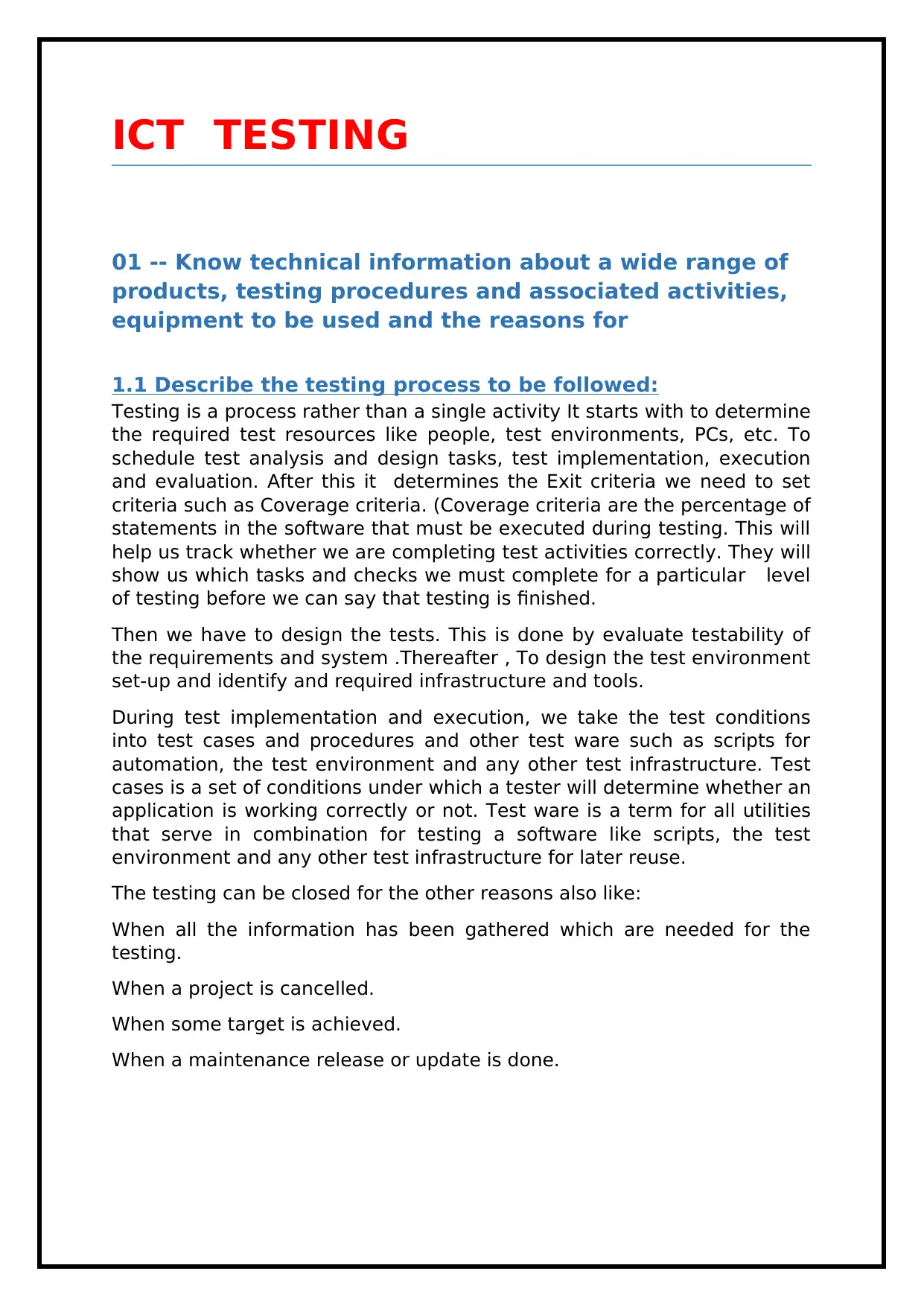
ICT TESTING
01 -- Know technical information about a wide range of
products, testing procedures and associated activities,
equipment to be used and the reasons for
1.1 Describe the testing process to be followed:
Testing is a process rather than a single activity It starts with to determine
the required test resources like people, test environments, PCs, etc. To
schedule test analysis and design tasks, test implementation, execution
and evaluation. After this it determines the Exit criteria we need to set
criteria such as Coverage criteria. (Coverage criteria are the percentage of
statements in the software that must be executed during testing. This will
help us track whether we are completing test activities correctly. They will
show us which tasks and checks we must complete for a particular level
of testing before we can say that testing is finished.
Then we have to design the tests. This is done by evaluate testability of
the requirements and system .Thereafter , To design the test environment
set-up and identify and required infrastructure and tools.
During test implementation and execution, we take the test conditions
into test cases and procedures and other test ware such as scripts for
automation, the test environment and any other test infrastructure. Test
cases is a set of conditions under which a tester will determine whether an
application is working correctly or not. Test ware is a term for all utilities
that serve in combination for testing a software like scripts, the test
environment and any other test infrastructure for later reuse.
The testing can be closed for the other reasons also like:
When all the information has been gathered which are needed for the
testing.
When a project is cancelled.
When some target is achieved.
When a maintenance release or update is done.
01 -- Know technical information about a wide range of
products, testing procedures and associated activities,
equipment to be used and the reasons for
1.1 Describe the testing process to be followed:
Testing is a process rather than a single activity It starts with to determine
the required test resources like people, test environments, PCs, etc. To
schedule test analysis and design tasks, test implementation, execution
and evaluation. After this it determines the Exit criteria we need to set
criteria such as Coverage criteria. (Coverage criteria are the percentage of
statements in the software that must be executed during testing. This will
help us track whether we are completing test activities correctly. They will
show us which tasks and checks we must complete for a particular level
of testing before we can say that testing is finished.
Then we have to design the tests. This is done by evaluate testability of
the requirements and system .Thereafter , To design the test environment
set-up and identify and required infrastructure and tools.
During test implementation and execution, we take the test conditions
into test cases and procedures and other test ware such as scripts for
automation, the test environment and any other test infrastructure. Test
cases is a set of conditions under which a tester will determine whether an
application is working correctly or not. Test ware is a term for all utilities
that serve in combination for testing a software like scripts, the test
environment and any other test infrastructure for later reuse.
The testing can be closed for the other reasons also like:
When all the information has been gathered which are needed for the
testing.
When a project is cancelled.
When some target is achieved.
When a maintenance release or update is done.
Paraphrase This Document
Need a fresh take? Get an instant paraphrase of this document with our AI Paraphraser

How to select tests and collect relevant and sufficient
information for test to be successful
Build a Solid Software Test Strategy
An effective testing strategy includes automated, manual, and exploratory
tests to efficiently reduce risk and tighten release cycles. Tests come in
several flavors:
Unit tests validate the smallest components of the system,
ensuring they handle known input and outputs correctly. Unit test
individual classes in your application to verify they work under
expected, boundary, and negative cases.
Integration tests exercise an entire subsystem and ensure that a
set of components play nicely together.
Functional tests verify end-to-end scenarios that your users will
engage in.
How to minimize service disruption during testing and
avoid detrimental effects or changes to performance
Accepting orders during the outage period
Consider adding logic to your systems to accept some or all orders during
service disruptions. These transactions can be marked as "pending" within
your system and retained internally until the disruption is over.
Once the outage period ends, you can submit the pended transactions to
receive a credit card authorization. If the authorization is approved, your
processing flow can proceed as normal. If the authorization is declined,
contact impacted customers via e-mail or telephone to request another
form of payment.
Ways to configure tests :
Different methodologies can be implemented that incurs the ultimate output of
the tests. Analyse the root cause i.e underlying cause of the problem. rigorous
testing should be performed .check the problem multiple times to ascertain the
root cause.
information for test to be successful
Build a Solid Software Test Strategy
An effective testing strategy includes automated, manual, and exploratory
tests to efficiently reduce risk and tighten release cycles. Tests come in
several flavors:
Unit tests validate the smallest components of the system,
ensuring they handle known input and outputs correctly. Unit test
individual classes in your application to verify they work under
expected, boundary, and negative cases.
Integration tests exercise an entire subsystem and ensure that a
set of components play nicely together.
Functional tests verify end-to-end scenarios that your users will
engage in.
How to minimize service disruption during testing and
avoid detrimental effects or changes to performance
Accepting orders during the outage period
Consider adding logic to your systems to accept some or all orders during
service disruptions. These transactions can be marked as "pending" within
your system and retained internally until the disruption is over.
Once the outage period ends, you can submit the pended transactions to
receive a credit card authorization. If the authorization is approved, your
processing flow can proceed as normal. If the authorization is declined,
contact impacted customers via e-mail or telephone to request another
form of payment.
Ways to configure tests :
Different methodologies can be implemented that incurs the ultimate output of
the tests. Analyse the root cause i.e underlying cause of the problem. rigorous
testing should be performed .check the problem multiple times to ascertain the
root cause.

Types of SLA:
Service Level Agreement
Customer SLA: agreement between an individual customer
Service SLA: Customers availing the service are entitled to use this
sla
Corporate SLA: This covers all Service Level Management (SLM)
issues
Customer Level SLA: Covers all the SLM related issues pertaining to
individual customer.
Service Level SLA: This covers all SLM issues that apply to specific
services
Individual responsibility and authority
Testing professionals include developers of assessment products and services, those who market
and sell them, persons who select them, test administrators and scorers, those who interpret test
results, and trained users of the information. Persons who engage in each of these activities have
significant responsibilities that are described elsewhere, in documents such as those that follow.
1.2 ---Describe the purposes of testing:
Aiding the diagnostic process
Service Level Agreement
Customer SLA: agreement between an individual customer
Service SLA: Customers availing the service are entitled to use this
sla
Corporate SLA: This covers all Service Level Management (SLM)
issues
Customer Level SLA: Covers all the SLM related issues pertaining to
individual customer.
Service Level SLA: This covers all SLM issues that apply to specific
services
Individual responsibility and authority
Testing professionals include developers of assessment products and services, those who market
and sell them, persons who select them, test administrators and scorers, those who interpret test
results, and trained users of the information. Persons who engage in each of these activities have
significant responsibilities that are described elsewhere, in documents such as those that follow.
1.2 ---Describe the purposes of testing:
Aiding the diagnostic process
⊘ This is a preview!⊘
Do you want full access?
Subscribe today to unlock all pages.

Trusted by 1+ million students worldwide

If you have a problem with your car, you’ll likely take it to a mechanic for
diagnosis. However, you may not realize that you can personally assist
with the diagnostic process. How? By communicating any details you can
recall from when the problem took place.
Comparing actual and expected performance
Remember Testing will happen a number of times on the device you are
working on, this will end up with a final test with the client to show that
the device is now working. There will be little variation in both the cases.
actual and expected performance cannot be the same.
1.3 Describe what test preparation and conclusion
activities are necessary for specific tests, such as
Health & Safety legislation and regulations
Testing preparation performed needs health and safety regulations. this
ensures test conducted is in accordance with the requirement as well as
done security . The health and safety regulations are in place to help
protect the people in the work place.
Need to obtain work permissions
Obtaining work permissions for testing ensures the successful conduct of
test without any pause either through external force or internal.
.
System or equipment integrity : System Integrity can be
obtained by proper maintenance of the system. Regular checks and
servicing is key to ensure no connection issues is incurred. Further
correct settings should be injected in order to attain integrity.
Data integrity : means correct data. Absence of ambiguous data.
Regular backup is very important phenomenon in this
environment .This ensures recovery in case of hardware failure or
human error. Further different constraints should be deployed which
ensures incorrect data is discarded.
Level of service allowed by the SLA
SLAs are output-based in that their purpose is specifically to define what
the customer will receive. SLAs do not define how the service itself is
provided or delivered. The SLA an Internet Service Provider (ISP) will
diagnosis. However, you may not realize that you can personally assist
with the diagnostic process. How? By communicating any details you can
recall from when the problem took place.
Comparing actual and expected performance
Remember Testing will happen a number of times on the device you are
working on, this will end up with a final test with the client to show that
the device is now working. There will be little variation in both the cases.
actual and expected performance cannot be the same.
1.3 Describe what test preparation and conclusion
activities are necessary for specific tests, such as
Health & Safety legislation and regulations
Testing preparation performed needs health and safety regulations. this
ensures test conducted is in accordance with the requirement as well as
done security . The health and safety regulations are in place to help
protect the people in the work place.
Need to obtain work permissions
Obtaining work permissions for testing ensures the successful conduct of
test without any pause either through external force or internal.
.
System or equipment integrity : System Integrity can be
obtained by proper maintenance of the system. Regular checks and
servicing is key to ensure no connection issues is incurred. Further
correct settings should be injected in order to attain integrity.
Data integrity : means correct data. Absence of ambiguous data.
Regular backup is very important phenomenon in this
environment .This ensures recovery in case of hardware failure or
human error. Further different constraints should be deployed which
ensures incorrect data is discarded.
Level of service allowed by the SLA
SLAs are output-based in that their purpose is specifically to define what
the customer will receive. SLAs do not define how the service itself is
provided or delivered. The SLA an Internet Service Provider (ISP) will
Paraphrase This Document
Need a fresh take? Get an instant paraphrase of this document with our AI Paraphraser
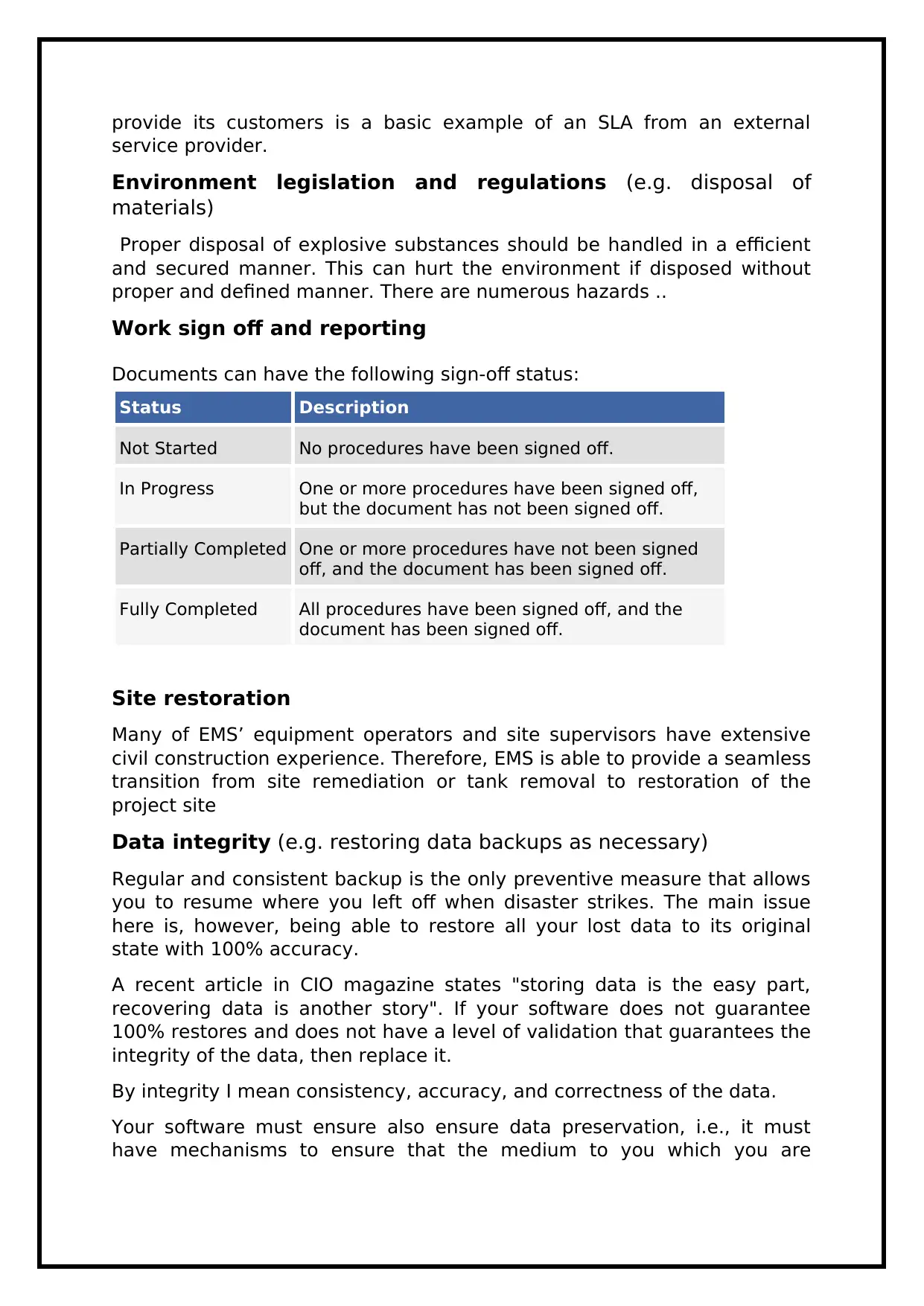
provide its customers is a basic example of an SLA from an external
service provider.
Environment legislation and regulations (e.g. disposal of
materials)
Proper disposal of explosive substances should be handled in a efficient
and secured manner. This can hurt the environment if disposed without
proper and defined manner. There are numerous hazards ..
Work sign off and reporting
Documents can have the following sign-off status:
Status Description
Not Started No procedures have been signed off.
In Progress One or more procedures have been signed off,
but the document has not been signed off.
Partially Completed One or more procedures have not been signed
off, and the document has been signed off.
Fully Completed All procedures have been signed off, and the
document has been signed off.
Site restoration
Many of EMS’ equipment operators and site supervisors have extensive
civil construction experience. Therefore, EMS is able to provide a seamless
transition from site remediation or tank removal to restoration of the
project site
Data integrity (e.g. restoring data backups as necessary)
Regular and consistent backup is the only preventive measure that allows
you to resume where you left off when disaster strikes. The main issue
here is, however, being able to restore all your lost data to its original
state with 100% accuracy.
A recent article in CIO magazine states "storing data is the easy part,
recovering data is another story". If your software does not guarantee
100% restores and does not have a level of validation that guarantees the
integrity of the data, then replace it.
By integrity I mean consistency, accuracy, and correctness of the data.
Your software must ensure also ensure data preservation, i.e., it must
have mechanisms to ensure that the medium to you which you are
service provider.
Environment legislation and regulations (e.g. disposal of
materials)
Proper disposal of explosive substances should be handled in a efficient
and secured manner. This can hurt the environment if disposed without
proper and defined manner. There are numerous hazards ..
Work sign off and reporting
Documents can have the following sign-off status:
Status Description
Not Started No procedures have been signed off.
In Progress One or more procedures have been signed off,
but the document has not been signed off.
Partially Completed One or more procedures have not been signed
off, and the document has been signed off.
Fully Completed All procedures have been signed off, and the
document has been signed off.
Site restoration
Many of EMS’ equipment operators and site supervisors have extensive
civil construction experience. Therefore, EMS is able to provide a seamless
transition from site remediation or tank removal to restoration of the
project site
Data integrity (e.g. restoring data backups as necessary)
Regular and consistent backup is the only preventive measure that allows
you to resume where you left off when disaster strikes. The main issue
here is, however, being able to restore all your lost data to its original
state with 100% accuracy.
A recent article in CIO magazine states "storing data is the easy part,
recovering data is another story". If your software does not guarantee
100% restores and does not have a level of validation that guarantees the
integrity of the data, then replace it.
By integrity I mean consistency, accuracy, and correctness of the data.
Your software must ensure also ensure data preservation, i.e., it must
have mechanisms to ensure that the medium to you which you are
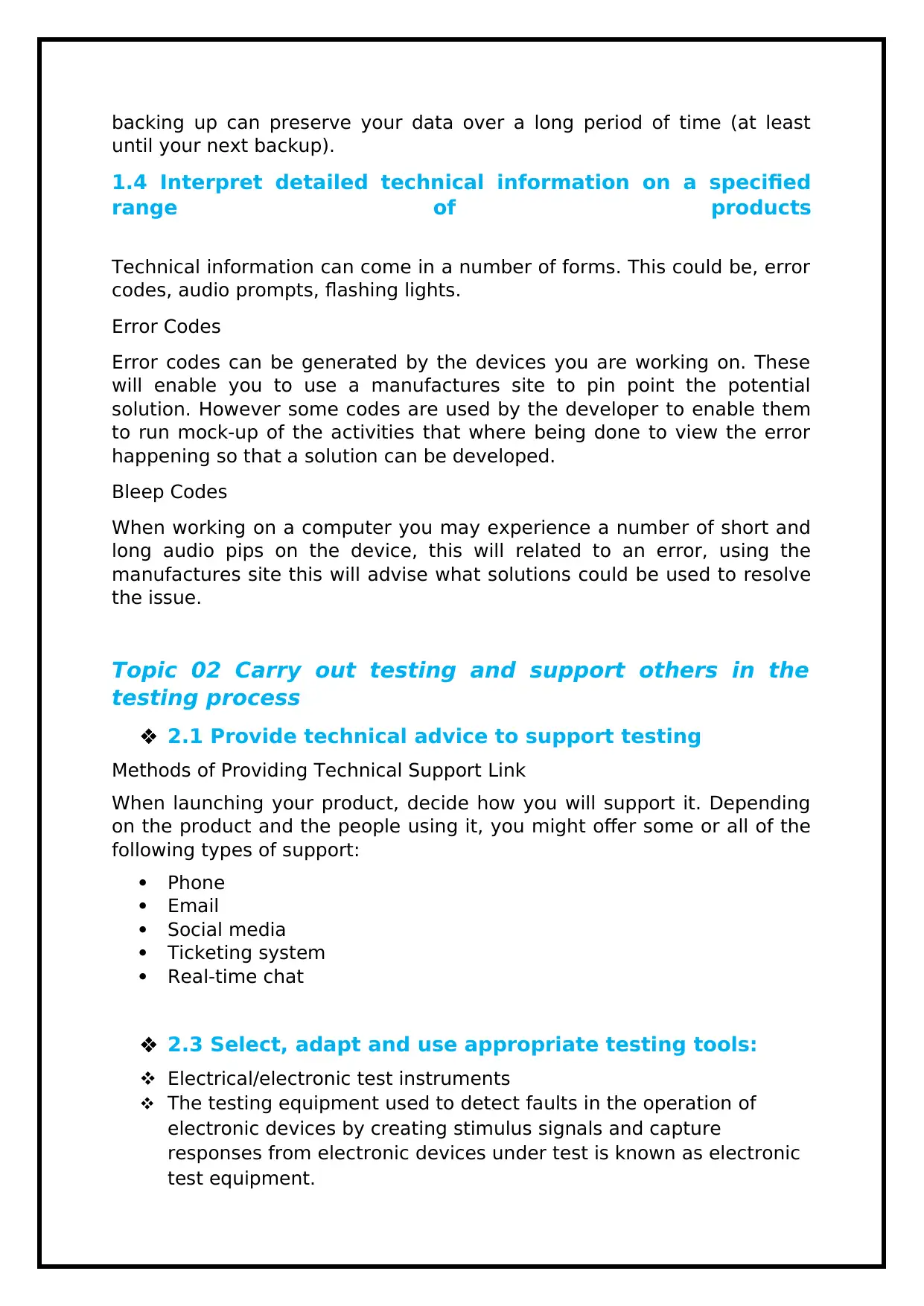
backing up can preserve your data over a long period of time (at least
until your next backup).
1.4 Interpret detailed technical information on a specified
range of products
Technical information can come in a number of forms. This could be, error
codes, audio prompts, flashing lights.
Error Codes
Error codes can be generated by the devices you are working on. These
will enable you to use a manufactures site to pin point the potential
solution. However some codes are used by the developer to enable them
to run mock-up of the activities that where being done to view the error
happening so that a solution can be developed.
Bleep Codes
When working on a computer you may experience a number of short and
long audio pips on the device, this will related to an error, using the
manufactures site this will advise what solutions could be used to resolve
the issue.
Topic 02 Carry out testing and support others in the
testing process
2.1 Provide technical advice to support testing
Methods of Providing Technical Support Link
When launching your product, decide how you will support it. Depending
on the product and the people using it, you might offer some or all of the
following types of support:
Phone
Email
Social media
Ticketing system
Real-time chat
2.3 Select, adapt and use appropriate testing tools:
Electrical/electronic test instruments
The testing equipment used to detect faults in the operation of
electronic devices by creating stimulus signals and capture
responses from electronic devices under test is known as electronic
test equipment.
until your next backup).
1.4 Interpret detailed technical information on a specified
range of products
Technical information can come in a number of forms. This could be, error
codes, audio prompts, flashing lights.
Error Codes
Error codes can be generated by the devices you are working on. These
will enable you to use a manufactures site to pin point the potential
solution. However some codes are used by the developer to enable them
to run mock-up of the activities that where being done to view the error
happening so that a solution can be developed.
Bleep Codes
When working on a computer you may experience a number of short and
long audio pips on the device, this will related to an error, using the
manufactures site this will advise what solutions could be used to resolve
the issue.
Topic 02 Carry out testing and support others in the
testing process
2.1 Provide technical advice to support testing
Methods of Providing Technical Support Link
When launching your product, decide how you will support it. Depending
on the product and the people using it, you might offer some or all of the
following types of support:
Phone
Social media
Ticketing system
Real-time chat
2.3 Select, adapt and use appropriate testing tools:
Electrical/electronic test instruments
The testing equipment used to detect faults in the operation of
electronic devices by creating stimulus signals and capture
responses from electronic devices under test is known as electronic
test equipment.
⊘ This is a preview!⊘
Do you want full access?
Subscribe today to unlock all pages.

Trusted by 1+ million students worldwide
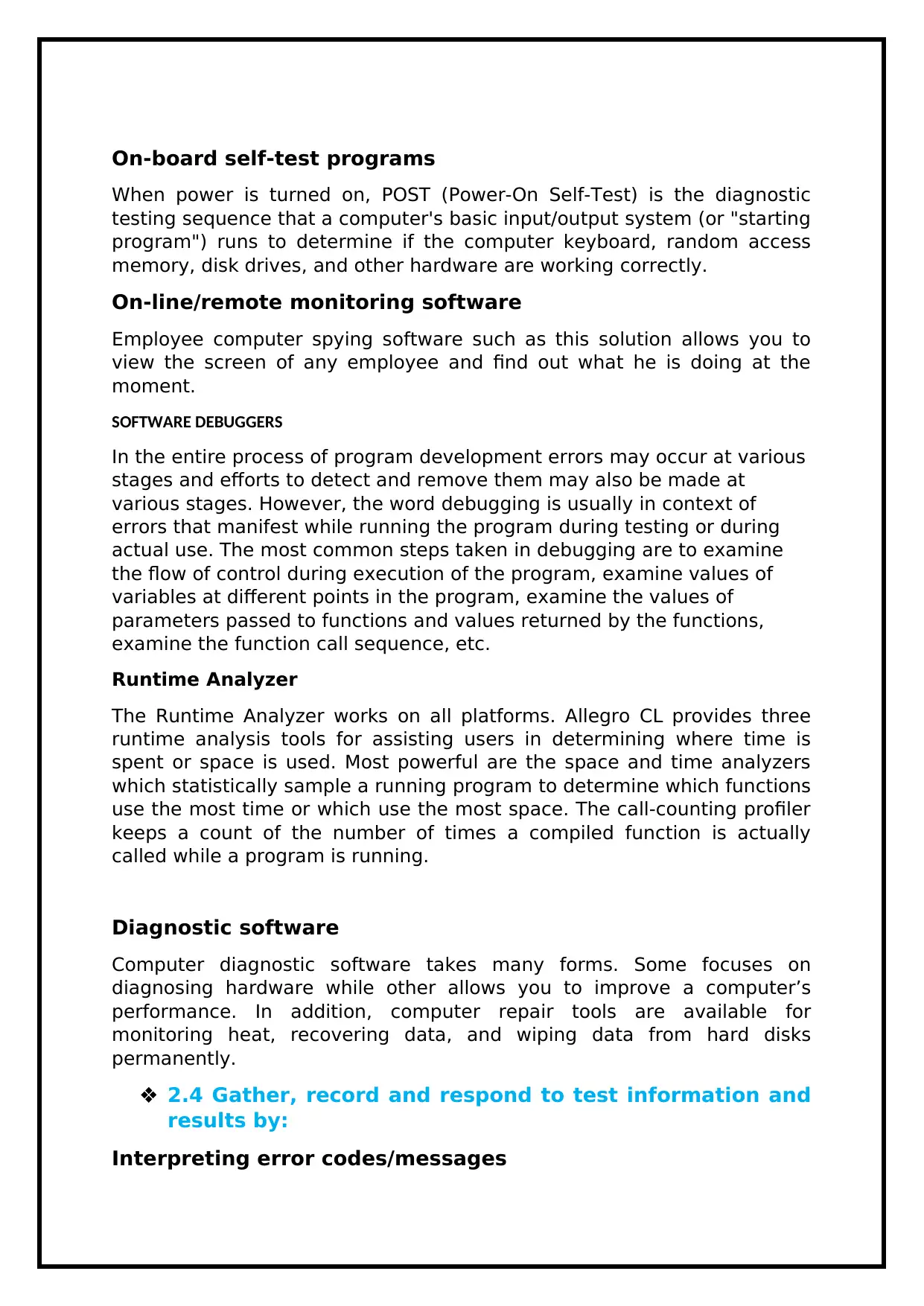
On-board self-test programs
When power is turned on, POST (Power-On Self-Test) is the diagnostic
testing sequence that a computer's basic input/output system (or "starting
program") runs to determine if the computer keyboard, random access
memory, disk drives, and other hardware are working correctly.
On-line/remote monitoring software
Employee computer spying software such as this solution allows you to
view the screen of any employee and find out what he is doing at the
moment.
SOFTWARE DEBUGGERS
In the entire process of program development errors may occur at various
stages and efforts to detect and remove them may also be made at
various stages. However, the word debugging is usually in context of
errors that manifest while running the program during testing or during
actual use. The most common steps taken in debugging are to examine
the flow of control during execution of the program, examine values of
variables at different points in the program, examine the values of
parameters passed to functions and values returned by the functions,
examine the function call sequence, etc.
Runtime Analyzer
The Runtime Analyzer works on all platforms. Allegro CL provides three
runtime analysis tools for assisting users in determining where time is
spent or space is used. Most powerful are the space and time analyzers
which statistically sample a running program to determine which functions
use the most time or which use the most space. The call-counting profiler
keeps a count of the number of times a compiled function is actually
called while a program is running.
Diagnostic software
Computer diagnostic software takes many forms. Some focuses on
diagnosing hardware while other allows you to improve a computer’s
performance. In addition, computer repair tools are available for
monitoring heat, recovering data, and wiping data from hard disks
permanently.
2.4 Gather, record and respond to test information and
results by:
Interpreting error codes/messages
When power is turned on, POST (Power-On Self-Test) is the diagnostic
testing sequence that a computer's basic input/output system (or "starting
program") runs to determine if the computer keyboard, random access
memory, disk drives, and other hardware are working correctly.
On-line/remote monitoring software
Employee computer spying software such as this solution allows you to
view the screen of any employee and find out what he is doing at the
moment.
SOFTWARE DEBUGGERS
In the entire process of program development errors may occur at various
stages and efforts to detect and remove them may also be made at
various stages. However, the word debugging is usually in context of
errors that manifest while running the program during testing or during
actual use. The most common steps taken in debugging are to examine
the flow of control during execution of the program, examine values of
variables at different points in the program, examine the values of
parameters passed to functions and values returned by the functions,
examine the function call sequence, etc.
Runtime Analyzer
The Runtime Analyzer works on all platforms. Allegro CL provides three
runtime analysis tools for assisting users in determining where time is
spent or space is used. Most powerful are the space and time analyzers
which statistically sample a running program to determine which functions
use the most time or which use the most space. The call-counting profiler
keeps a count of the number of times a compiled function is actually
called while a program is running.
Diagnostic software
Computer diagnostic software takes many forms. Some focuses on
diagnosing hardware while other allows you to improve a computer’s
performance. In addition, computer repair tools are available for
monitoring heat, recovering data, and wiping data from hard disks
permanently.
2.4 Gather, record and respond to test information and
results by:
Interpreting error codes/messages
Paraphrase This Document
Need a fresh take? Get an instant paraphrase of this document with our AI Paraphraser
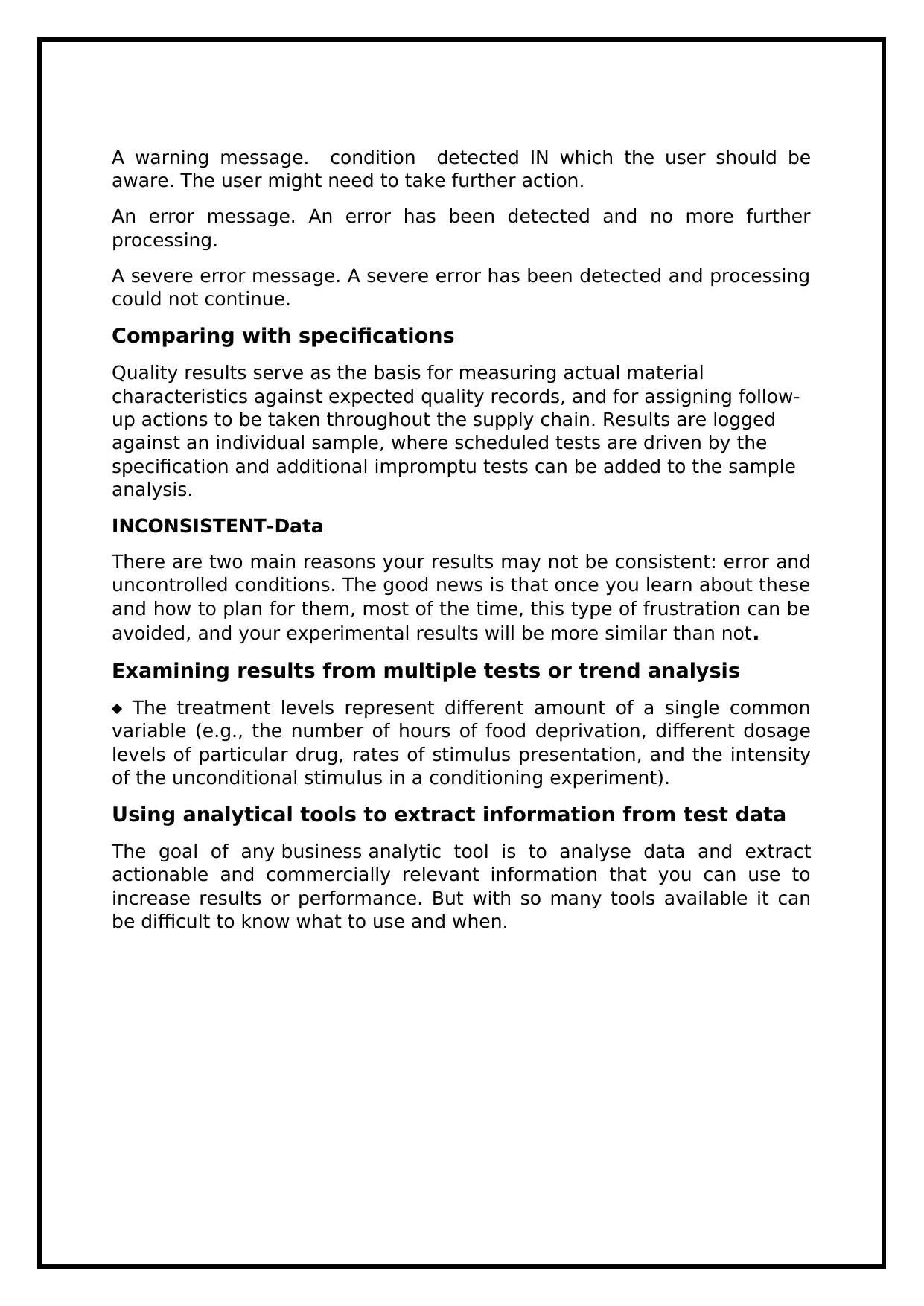
A warning message. condition detected IN which the user should be
aware. The user might need to take further action.
An error message. An error has been detected and no more further
processing.
A severe error message. A severe error has been detected and processing
could not continue.
Comparing with specifications
Quality results serve as the basis for measuring actual material
characteristics against expected quality records, and for assigning follow-
up actions to be taken throughout the supply chain. Results are logged
against an individual sample, where scheduled tests are driven by the
specification and additional impromptu tests can be added to the sample
analysis.
INCONSISTENT-Data
There are two main reasons your results may not be consistent: error and
uncontrolled conditions. The good news is that once you learn about these
and how to plan for them, most of the time, this type of frustration can be
avoided, and your experimental results will be more similar than not.
Examining results from multiple tests or trend analysis
The treatment levels represent different amount of a single common
variable (e.g., the number of hours of food deprivation, different dosage
levels of particular drug, rates of stimulus presentation, and the intensity
of the unconditional stimulus in a conditioning experiment).
Using analytical tools to extract information from test data
The goal of any business analytic tool is to analyse data and extract
actionable and commercially relevant information that you can use to
increase results or performance. But with so many tools available it can
be difficult to know what to use and when.
aware. The user might need to take further action.
An error message. An error has been detected and no more further
processing.
A severe error message. A severe error has been detected and processing
could not continue.
Comparing with specifications
Quality results serve as the basis for measuring actual material
characteristics against expected quality records, and for assigning follow-
up actions to be taken throughout the supply chain. Results are logged
against an individual sample, where scheduled tests are driven by the
specification and additional impromptu tests can be added to the sample
analysis.
INCONSISTENT-Data
There are two main reasons your results may not be consistent: error and
uncontrolled conditions. The good news is that once you learn about these
and how to plan for them, most of the time, this type of frustration can be
avoided, and your experimental results will be more similar than not.
Examining results from multiple tests or trend analysis
The treatment levels represent different amount of a single common
variable (e.g., the number of hours of food deprivation, different dosage
levels of particular drug, rates of stimulus presentation, and the intensity
of the unconditional stimulus in a conditioning experiment).
Using analytical tools to extract information from test data
The goal of any business analytic tool is to analyse data and extract
actionable and commercially relevant information that you can use to
increase results or performance. But with so many tools available it can
be difficult to know what to use and when.
1 out of 8
Your All-in-One AI-Powered Toolkit for Academic Success.
+13062052269
info@desklib.com
Available 24*7 on WhatsApp / Email
![[object Object]](/_next/static/media/star-bottom.7253800d.svg)
Unlock your academic potential
Copyright © 2020–2025 A2Z Services. All Rights Reserved. Developed and managed by ZUCOL.
